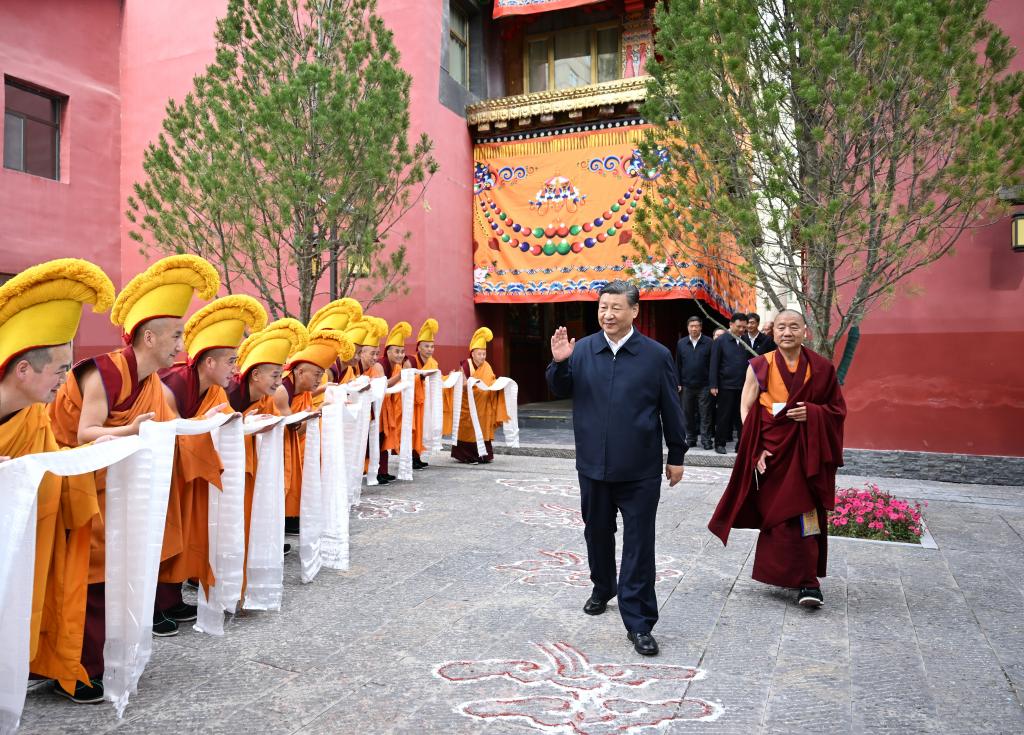Temple hailed as bridge in enhancing bond between govt, Tibetan Buddhism

President Xi Jinping expressed the hope for the Tibetan Buddhist circle in Qinghai province to carry on the fine traditions of patriotism, help promote religious, social and ethnic harmony, and play an active role in advancing Chinese modernization, during an inspection tour in the province.
Xi, who is also general secretary of the Communist Party of China Central Committee and chairman of the Central Military Commission, made the remarks while visiting the Hongjue Temple in the provincial capital of Xining on Tuesday afternoon.
READ MORE: Xi stresses Qinghai-Xizang Plateau conservation
He said the temple has played an important role as a bridge in strengthening the bond between the central government and Tibetan Buddhism over generations.
"It is essential to protect this precious historical and cultural heritage, and renew efforts to foster a strong sense of community for the Chinese nation and promote ethnic unity and progress," Xi said.
The Hongjue Temple in central Xining has a history of more than 1,000 years. Konchok Gyatso, a senior monk at the temple, said it has played an important role in boosting exchanges between the Qinghai-Tibet Plateau and other parts of China and promoting peace among people from different ethnic groups.
Since the establishment of the monastery in 941 AD, it has always been inclusive to different cultures, Konchok Gyatso said. "The founder of the monastery was taught and approved by three masters from Tibetan Buddhism and two from Chinese Buddhism (also known as Mahayana Buddhism). And Hongjue is the temple with the longest history for integrating the cultures of both Tibetan Buddhism and Chinese Buddhism in China."
Because of such integration, it has become a well-known school among Tibetan Buddhist monks, and many accomplished monks and living Buddhas have studied at the temple, he added. "More importantly, besides their accomplishments in Tibetan Buddhism, they all share the same vision of promoting peace and unity among people from different ethnic groups till today."
Furthermore, the temple, which is located at the eastern entry point of the Qinghai-Tibet Plateau, has always helped to enforce ties between the central government and Tibetan Buddhism, Konchok Gyatso said.
In 1779, the 6th Panchen Erdeni Lobsang Palden Yeshe was invited to Beijing by Emperor Qianlong of the Qing Dynasty (1644-1911). To make his stop at the Hongjue Temple comfortable, the emperor had the temple fully renovated. And it has become a key spot where the Panchen Lamaone of the two most revered living Buddhas in Tibetan Buddhism — stayed in Qinghai ever since.
Also, born in Qinghai in 1938, the 10th Panchen Erdeni Chokyi Gyaltsen set off from the temple to Xizang in 1951 to fulfill his duty after completing a series of studies on Tibetan Buddhism.
"He then became a living Buddha with profound Buddhist knowledge and full love of the country and his religion. He worked hard for the country's unification and ethnic unity, which inspired us all," Konchok Gyatso said.
ALSO READ: Xi inspects Northwest China's Qinghai province
To protect Hongjue Temple's rich cultural heritage, a renovation and restoration project was launched in 2004. Upon the completion of the project in 2014, a new grand prayer hall was built at the temple.
"When people come to visit the monastery, besides the culture of Tibetan Buddhism, we want them to see its long-lasting tradition of boosting understanding among people from different ethnic groups, such as Tibetan, Mongolian and Han," Konchok Gyatso said.
Chen Lijian, a researcher at the China Tibetology Research Center, said the temple has been influential in Tibetan Buddhism historically.
"And it will continue to serve as a key platform for promoting exchanges among different cultures and ethnic unity on the Qinghai-Tibet Plateau," Chen said.



